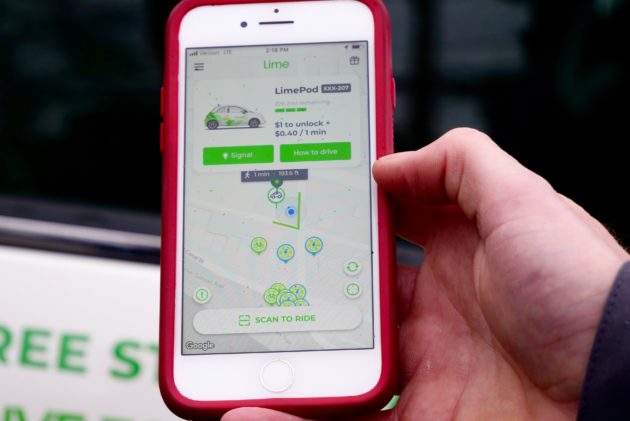
Lime bikes, Lime scooters, and now, Lime cars.
Lime, the high-flying transportation startup valued at $1.1 billion, already has thousands of shared bicycles and scooters in more than 100 cities across the globe.
But now it’s getting into the car-sharing game, starting with the launch of 500 LimePods in Seattle next month, available to rent via Lime’s smartphone app.
GeekWire got a first look inside the new Lime-branded Fiat 500 this week in Seattle, where Lime will compete against two other car-sharing services from BMW (ReachNow) and Daimler (car2go) that already have a combined 1,500 cars available to rent. The city has embraced the “free-floating” car-sharing model that lets customers pay for drive time on a per-minute basis and drop the vehicles off on any residential or metered parking spot within a given zone.
Will Lime be able to compete in a crowded market? What’s different about the LimePods? And what does Lime have up its sleeve?

Here are some quick takeaways from our experience:
It’s easier: To access vehicles and start a trip, ReachNow and car2go require users to enter a pin code on their smartphone or with the in-car infotainment system. Lime makes it more simple, borrowing the unlock feature from its bicycles and scooters. LimePods are accessed by simply scanning a QR code — placed on the sides and rear of the car — with the Lime app. The key is already in the ignition. It’s pretty slick.
It’s cheaper: Not by much, but Lime does offer the cheapest per-minute rate — 40 cents — of the three car-sharing services in Seattle. ReachNow and car2go charge 45 cents per minute. However, Lime does charge $1 to unlock a LimePod. And ReachNow and car2go do offer price caps — charges are maxed out at $15 for an hour of driving, for example.

The Fiat 500: This was my first time taking the two-door Italian “sports car” for a spin. It’s definitely fun to drive and mimics the feel of ReachNow’s MINI options. The black leather interior is comfortable enough for two people, but fitting four is a squeeze. Bonus points: LimePods come with a sturdy smartphone holder.
‘Very sexy and very cool and very futuristic’: That’s how Pete Dempster, program manager at Lime who is overseeing the LimePod launch, described the small, low-speed electric vehicles that will eventually replace the Fiat 500s in Lime’s car-sharing fleet. He said it’s unlike anything else on the roads today. “We want the same sort of emotional response that we experienced when we put scooters on the street, where the inner child in you comes out and goes, ‘I want to take a trip in that. I want to use that.” Bloomberg hinted at these electric “transit pods” in May.
Other details: Unlike the other two services, Lime requires users to take a photo of their vehicle before ending a trip. Users must have a valid driver’s license; a year of driving history; and be 21 years or older. Lime offers insurance and gas, just like the other services. The Seattle launch is set for Dec. 10, with cars available across the city. Lime said it wants to have 1,500 LimePods on the road, and possibly more, which would make it the largest car-sharing service in Seattle. It will also launch LimePods soon in an unannounced California city.
Why is Lime doing this?

Dempster, a transportation junkie who bikes to work everyday, knows a thing or two about car-sharing. He was previously a leader at ReachNow, helping BMW launch its own car-sharing program in Seattle two years ago. Dempster also worked on DriveNow, the first iteration of BMW’s mobility service that struggled to gain traction in the Bay Area before rebranding in Seattle as ReachNow.
While BMW and car2go offers higher-end vehicles, Lime is “trying to bring car-share to the masses,” Dempster said.
“We think that we can introduce the most equitable and most sustainable version of car-share that has ever existed,” he added.
Lime, which raised a $335 million round in July from investors such as Uber and Alphabet, also differs from ReachNow and car2go — which agreed to merge in March — because of its multimodal strategy, adding cars to a network that already includes bikes and scooters (not in Seattle —yet).
Dempster envisions people using a combination of Lime’s offerings to get around a city — for example, driving a LimePod close to downtown and taking one of 5,000 e-bikes the rest of the way to a Mariners game or happy hour meetup. Lime could incentivize this type of behavior with free transfers, Dempster said.
“Then we have something that’s really compelling and a platform that works for every need,” he said, adding that “it’s in our best interest if people get rid of their personal car.”

It’s unclear how car-sharing affects overall traffic congestion. car2go cites a 2016 car-sharing study that showed how car2go reduces the net number of vehicles on the road.
A transportation analyst in July reported that ride-hailing services are actually making traffic worse, going against messaging from companies such as Uber and Lyft.
Lime is part of a ground transportation industry being transformed by technology with ride-hailing, car-sharing, self-driving, and other new ways to get around cities. Its U.S. rival in the scooter race is Bird, which is focused solely on scooters and has also raised hundreds of thousands of venture capital dollars. Uber, meanwhile, recently acquired bike-sharing startup JUMP, while Lyft bought Motivate.
Car-sharing has proved popular in Seattle, which is car2go’s largest U.S. market with 127,000 members. But can LimePods survive or even thrive in a market that already has two other competing services? Lime is confident that there’s a business opportunity.
“We’re not concerned about demand for this,” Dempster said. “We know that the demand is there for one-way, great, easy-to-use mobility that is in the form of car-share. We’re going to have the best operations and the best product, and that’s how we’ll win.”



